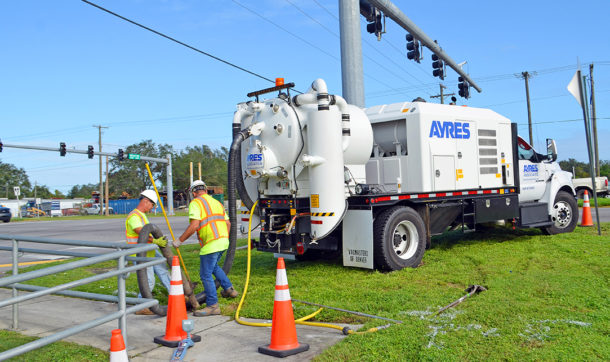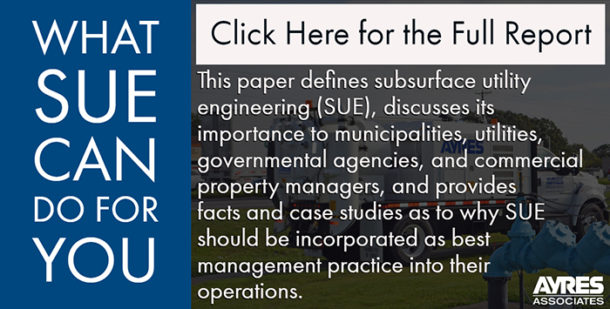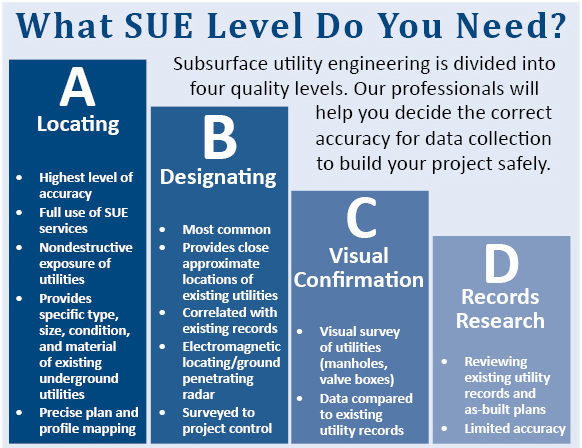Subsurface Utility Engineering Leads to Increased Safety, Cost Savings
 The built world is continually evolving. You don’t have to look far to see road improvements, new houses and buildings, increased public transit, revitalization efforts, and more. New infrastructure means a higher demand for utilities, from water to telecommunications. Yet these additional utilities place increased stress on America’s rights-of-way, where most of these lines are buried in a seemingly tangled web. Striking a utility line during construction can cause significant delays, require costly repairs, or endanger people and property, especially when gas lines are involved.
The built world is continually evolving. You don’t have to look far to see road improvements, new houses and buildings, increased public transit, revitalization efforts, and more. New infrastructure means a higher demand for utilities, from water to telecommunications. Yet these additional utilities place increased stress on America’s rights-of-way, where most of these lines are buried in a seemingly tangled web. Striking a utility line during construction can cause significant delays, require costly repairs, or endanger people and property, especially when gas lines are involved.
What is a Right-of-Way?
A right-of-way is the land that has been reserved for infrastructure. From roads to trails to utilities, it’s the public space between buildings, houses, and other forms of private property that is used to allow people and utilities to travel from one place to another.
The increased use of subsurface utility engineering, or SUE, has helped infrastructure designers and builders avoid many catastrophes, allowing projects to stay on schedule and budget while protecting workers and the public.
What is subsurface utility engineering (SUE)?
“SUE is a branch of engineering practice that involves managing certain risks associated with utility mapping at appropriate quality levels, utility coordination, utility relocation design and coordination, utility condition assessment, communication of utility data to concerned parties, utility relocation cost estimates, implementation of utility accommodation policies, and utility design.”
– Standard Guideline for the Collection and Depiction of Existing Subsurface Utility Data, CI/ASCE 38-02, American Society of Civil Engineers, 2002
In other words, SUE is a proactive process that aims to avert risks associated with utilities on construction projects by providing a range of methods to collect utility data, depending on project requirements.
 SUE data is good insurance. While the data may only confirm what’s already known about a site, it also could be the most valuable, cost-effective, and accurate method to make sure a future project is built safely, on time, and within budget.
SUE data is good insurance. While the data may only confirm what’s already known about a site, it also could be the most valuable, cost-effective, and accurate method to make sure a future project is built safely, on time, and within budget.
Why use SUE on a project?
Enhanced Safety: When builders know exactly what’s underground and where, they can move excavations and other work away from the affected area to avoid potential danger, damage, stopped service, and other effects.
Avoiding Costly Utility Relocations: SUE data provides high accuracy when developing projects and designing roadway improvements around potential conflicts.
Reducing Utility Conflicts During Construction: When utility locations, types, and materials are known beforehand, the data is placed on construction plans so contractors know exactly where to dig or grade.
When is SUE used?
According to the American Society of Civil Engineers’ Standard Guideline for the Collection and Depiction of Existing Subsurface Utility Data, SUE services help manage risks associated with:
- Utility design
- Utility mapping
- Utility coordination
- Utility relocation
- Utility condition assessment
- Communication of utility data
- Implementation of utility accommodation policies
The ABCs, and D, of SUE
Utility locating for SUE is divided into four quality levels. Each level has pros and cons with variations in cost and data accuracy. The level that’s selected for a given project depends on how much information is necessary for design and construction. Quality levels range from A to D, with A representing the most comprehensive data collection.

What are the financial benefits of using SUE?
Costs for acquiring SUE data vary, depending on the accuracy level required, climate, and the location of the project. For example, collecting SUE data in a southern climate often requires shallower “test holes” than in a northern climate, where utilities generally are buried below the frost line.
A Federal Highway Administration-Purdue University study in 1999 concluded that acquiring SUE data for construction projects provided a return of $4.62 for every $1 invested, using a sample of 71 projects in four states. Today, with increased costs for construction delays, lawsuits, and disrupted services, the return on investment likely is much higher.
If you’d like to learn more about the work we’ve done, check out our Subsurface Utility Engineering Projects.

Post a comment: